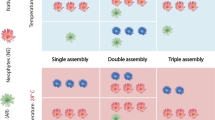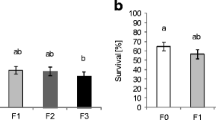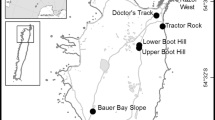Abstract
It is often assumed that declines in native vegetation associated with alien plant invasion are driven by competition between plants for limited resources. However, invasion can also impact native plants through recruitment limitation mechanisms. We examined the effects of Cenchrus ciliaris L. (buffel grass, an alien pasture species) on the seed viability and germination of two native perennial shrubs (Acacia tetragonophylla and A. victoriae) in arid woodlands of central Australia. Dormancy, germination rate and seed viability were assessed using laboratory-based germination assays on seeds collected from the soil and mature shrubs in: (1) woodland invaded by buffel grass and (2) areas in which buffel grass had been removed and reinvasion prevented for at least 7 years. There was a twofold increase in viability of A. victoriae seeds in buffel grass-removed compared with invaded sites, and a faster germination rate (T50) for A. tetragonophylla in buffel grass-removed sites. Acacia victoriae seed mass was reduced by approximately 25% in invaded areas, associated with decomposed or absent embryos. Invasion may limit native recruitment by reducing the viability and germination rate of native seeds prior to dispersal from parent plants. Reduced seed viability would reduce seed bank accumulation and total available seed for A. victoriae, while slower germination rates would minimise the efficiency by which A. tetragonophylla responds to sporadic rainfall events. Both mechanisms could lead to long term declines in native plant populations. Reduced seed viability would compound interference of buffel grass on recruiting plants.

Similar content being viewed by others
References
Aragón CF, Escudero A, Valladares F (2008) Stress-induced dynamic adjustments of reproduction differentially affect fitness components of a semi-arid plant. J Ecol 96:222–229. https://doi.org/10.1111/j.1365-2745.2007.01320.x
Auld TD (1995) Soil seedbank patterns of four trees and shrubs from arid Australia. J Arid Environ 29:33–45. https://doi.org/10.1016/S0140-1963(95)80062-X
Baskin CC, Baskin JM (2014) Seeds: ecology, biogeography, and evolution of dormancy and germination, 2nd edn. Academic Press, San Diego
Benard RB, Toft CS (2007) Effect of seed size on seedling performance in a long-lived desert perennial shrub (Ericameria nauseosa: Asteraceae). Int J Plant Sci 168:1027–1033. https://doi.org/10.1086/518942
Bureau of Meteorology (2018) Climate statistics for Australian locations. Commonwealth of Australia. http://www.bom.gov.au/climate/averages/tables/cw_015590.shtml. Accessed 6 Dec 2018
Butler BDW, Fairfax RJ (2003) Buffel grass and fire in a gidgee and brigalow woodland: a case study from central Queensland. Ecol Manag Restor 4:120–125. https://doi.org/10.1046/j.1442-8903.2003.00146.x
Cheam AH (1984) A ‘natural herbicide’ against calotrope? J Dep Agric 25:42–43
Craine JM, Dybzinski R (2013) Mechanisms of plant competition for nutrients, water and light. Funct Ecol 27:833–840. https://doi.org/10.1111/1365-2435.12081
D’Antonio CM, Vitousek PM (1992) Biological Invasions by exotic grasses, the grass/fire cycle, and global change. Annu Rev Ecol Syst 23:63–87
D’Antonio CM, Hughes RF, Mack M, Hitchcock D, Vitousek PM (1998) The response of native species to removal of invasive exotic grasses in a seasonally dry Hawaiian woodland. J Veg Sci 9:699–712. https://doi.org/10.2307/3237288
Dornbos DL, Mullen RE (1991) Influence of stress during soybean seed fill on seed weight, germination, and seedling growth rate. Can J Plant Sci 71:373–383. https://doi.org/10.4141/cjps91-052
Ehrenfeld JG (2003) Effects of exotic plant invasions on soil nutrient cycling processes. Ecosystems 6:503–523. https://doi.org/10.1007/s10021-002-0151-3
Ens EJ, French K (2008) Exotic woody invader limits the recruitment of three indigenous plant species. Biol Conserv 141:590–595. https://doi.org/10.1016/j.biocon.2007.12.012
Farooq M, Wahid A, Kobayashi N, Fujita D, Basra SMA (2009) Plant drought stress: effects, mechanisms and management. In: Lichtfouse E, Navarrete M, Debaeke P, Veronique S, Alberola C (eds) Sustainable agriculture. Springer, Dordrecht. https://doi.org/10.1007/978-90-481-2666-8
Franklin KA, Molina-Freaner F (2010) Consequences of buffelgrass pasture development for productivity and species richness of plants in the drylands of Sonora, Mexico. Conserv Biol 24:1664–1673. https://doi.org/10.1111/j.1523-1739.2010.01540.x
Gioria M, Osborne BA (2014) Resource competition in plant invasions: emerging patterns and research needs. Front Plant Sci 5:501. https://doi.org/10.3389/fpls.2014.00501
Gioria M, Pyšek P (2016) The Legacy of plant invasions: changes in the Soil Seed Bank of invaded plant communities. Bioscience 66:40–53. https://doi.org/10.1093/biosci/biv165
Gioria M, Jarošík V, Pyšek P (2014) Impact of invasions by alien plants on soil seed bank communities: emerging patterns. Perspect Plant Ecol Evol Syst 16:132–142. https://doi.org/10.1016/j.ppees.2014.03.003
Gooden B, French K (2014) Impacts of alien grass invasion in coastal seed banks vary amongst native growth forms and dispersal strategies. Biol Conserv 171:114–126. https://doi.org/10.1016/j.biocon.2014.01.005
Gooden B, French K, Robinson SA (2014) Alien grass disrupts reproduction and post-settlement recruitment of co-occurring native vegetation: a mechanism for diversity decline in invaded forest? Plant Ecol 215:567–580
Gould AM, Gorchov DL (2000) Effects of the exotic invasive shrub Lonicera maackii on the survival and fecundity of three species of native annuals. Am Midl Nat 144:36–50
Grice AC, Westoby M (1987) Aspects of the dynamics of the seed-banks and seedling populations of Acacia victoriae and Cassia spp. in arid western New South Wales. Aust J Ecol 12:209–215. https://doi.org/10.1111/j.1442-9993.1987.tb00944.x
Hampton JG, Boelt B, Rolston MP, Chastain TG (2013) Effects of elevated CO2 and temperature on seed quality. J Agric Sci 151:154–162. https://doi.org/10.1017/S0021859612000263
Hopfensperger KN (2007) A review of similarity between seed bank and standing vegetation across ecosystems. Oikos 116:1438–1448. https://doi.org/10.1111/j.0030-1299.2007.15818.x
Hoyle GL, Steadman KJ, Daws MI, Adkins SW (2008) Pre- and post-harvest influences on seed dormancy status of an Australian Goodeniaceae species, Goodenia fasicularis. Ann Bot 102:93–101. https://doi.org/10.1093/aob/mcn062
Hudson AR, Ayre DJ, Ooi MKJ (2015) Physical dormancy in a changing climate. Seed Sci Res 25:66–81. https://doi.org/10.1017/S0960258514000403
Jordan JL, Staniforth DW, Jordan CM (1982) Parental stress and prechilling effects on Pennsylvania Smartweed (Polygonum pensylvanicum) achenes. Weed Sci 30:243–248. https://doi.org/10.1017/S0043174500040467
Liyanage GS, Ooi MKJ (2017) Do dormancy-breaking temperature thresholds change as seeds age in the soil seed bank? Seed Sci Res 27:1–11
Marshall VM, Lewis MM, Ostendorf B (2012) Buffel grass (Cenchrus ciliaris) as an invader and threat to biodiversity in arid environments: a review. J Arid Environ 78:1–12. https://doi.org/10.1016/j.jaridenv.2011.11.005
McDonald CJ, McPherson GR (2011) Fire behavior characteristics of buffelgrass-fueled fires and native plant community composition in invaded patches. J Arid Environ 75:1147–1154. https://doi.org/10.1016/j.jaridenv.2011.04.024
McKinney AM, Goodell K (2010) Shading by invasive shrub reduces seed production and pollinator services in a native herb. Biol Invasions 12:2751–2763
Miller KE, Gorchov DL (2004) The invasive shrub, Lonicera maackii, reduces growth and fecundity of perennial forest herbs. Oecologia 139:359–375
Miller G, Friedel M, Adam P, Chewings V (2010) Ecological impacts of buffel grass (Cenchrus ciliaris L.) invasion in central Australia–does field evidence support a fire-invasion feedback? Rangel J 32:353–365. https://doi.org/10.1071/RJ09076
Morales CL, Traveset A (2009) A meta-analysis of impacts of alien vs. native plants on pollinator visitation and reproductive success of co-flowering native plants. Ecol Lett 12:716–728. https://doi.org/10.1111/j.1461-0248.2009.01319.x
Morales-Romero D, Molina-Freaner F (2008) Influence of buffelgrass pasture conversion on the regeneration and reproduction of the columnar cactus, Pachycereus pecten-aboriginum, in northwestern Mexico. J Arid Environ 72:228–237
Nurse RD, DiTommaso A (2005) Corn competition alters the germinability of velvetleaf (Abutilon theophrasti) seeds. Weed Sci 53:479–488. https://doi.org/10.1614/WS-04-185R1
Olden JD, Poff NL, Douglas MR, Douglas ME, Fausch KD (2004) Ecological and evolutionary consequences of biotic homogenization. Trends Ecol Evol 19:18–24. https://doi.org/10.1016/j.tree.2003.09.010
Ooi MKJ, Auld TD, Whelan RJ (2004) Comparison of the cut and tetrazolium tests for assessing seed viability: a study using Australian native Leucopogon species. Ecol Manag Restor 5:141–143
Ooi MKJ, Auld TD, Denham AJ (2009) Climate change and bet-hedging: interactions between increased soil temperatures and seed bank persistence. Glob Change Biol 15:2375–2386. https://doi.org/10.1111/j.1365-2486.2009.01887.x
Pyšek P, Jarošík V, Hulme PE, Pergl J, Hejda M, Schaffner U, Vilà M (2012) A global assessment of invasive plant impacts on resident species, communities and ecosystems: the interaction of impact measures, invading species’ traits and environment. Glob Change Biol 18:1725–1737. https://doi.org/10.1111/j.1365-2486.2011.02636.x
R Core Team (2017) R: a language and environment for statistical computing. R Foundation for Statistical Computing, Vienna. https://www.R-project.org/
Ritz C, Pipper CB, Streibig JC (2013) Analysis of germination data from agricultural experiments. Eur J Agron 45:1–6
Rossiter NA, Setterfield SA, Douglas MM, Hutley LB (2003) Testing the grass-fire cycle: alien grass invasion in the tropical savannas of northern Australia. Divers Distrib 9(3):169–176
Schlesinger C, White S, Muldoon S (2013) Spatial pattern and severity of fire in areas with and without buffel grass (Cenchrus ciliaris) and effects on native vegetation in central Australia. Austral Ecol 38:831–840. https://doi.org/10.1111/aec.12039
Seabloom EW, Harpole WS, Reichman OJ, Tilman D (2003) Invasion, competitive dominance, and resource use by exotic and native California grassland species. Proc Natl Acad Sci 100:13384–13389
Segura F, Vicente MJ, Franco JA, Martinez-Sánchez JJ (2015) Effects of maternal environmental factors on physical dormancy of Astragalus nitidiflorus (Fabaceae), a critically endangered species of SE Spain. Flora 216:71–76. https://doi.org/10.1016/j.flora.2015.09.001
Smýkal P, Vernoud V, Blair MW, Soukup A, Thompson RD (2014) The role of the testa during development and in establishment of dormancy of the legume seed. Front Plant Sci 5:351. https://doi.org/10.3389/fpls.2014.00351
Steadman KJ, Ellery AJ, Chapman R, Moore A, Turner NC (2004) Maturation temperature and rainfall influence seed dormancy characteristics of annual ryegrass (Lolium rigidum). Aust J Agric Res 55:1047–1057. https://doi.org/10.1071/AR04083
Stevens JM, Fehmi JS (2009) Competitive effect of two nonnative grasses on a native grass in southern Arizona. Invasive Plant Sci Manag 2:379–385. https://doi.org/10.1614/IPSM-09-022.1
Sun K, Hunt K, Hauser BA (2004) Ovule abortion in Arabidopsis triggered by stress. Plant Physiol 135:2358–2367. https://doi.org/10.1104/pp.104.043091
Traveset A, Richardson DM (2006) Biological invasions as disruptors of plant reproductive mutualisms. Trends Ecol Evol 21:208–216. https://doi.org/10.1016/j.tree.2006.01.006
Vallam P, Qin XS (2017) Projecting future precipitation and temperature at sites with diverse climate through multiple statistical downscaling schemes. Theor Appl Climatol. https://doi.org/10.1007/s00704-017-2299-y
van Klinken RD, Friedel MH (2018) Unassisted invasions: understanding and responding to Australia’s high-impact environmental grass weeds. Aust J Bot 65:678–690. https://doi.org/10.1071/BT17152
Vilà M, Weiner J (2004) Are invasive plant species better competitors than native plant species?—evidence from pair-wise experiments. Oikos 105:229–238. https://doi.org/10.1111/j.0030-1299.2004.12682.x
Vilà M, Espinar JL, Hejda M, Hulme PE, Jarošík V, Maron JL, Pergl J, Schaffner U, Sun Y, Pyšek P (2011) Ecological impacts of invasive alien plants: a meta-analysis of their effects on species, communities and ecosystems. Ecol Lett 14:702–708. https://doi.org/10.1111/j.1461-0248.2011.01628.x
Ward JP, Smith SE, McClaran MP (2006) Water requirements for emergence of buffelgrass (Pennisetum ciliare). Weed Sci 54:720–725. https://doi.org/10.1614/WS-05-163R1.1
Weber H, Borisjuk L, Wobus U (2005) Molecular physiology of legume seed development. Annu Rev Plant Biol 56:253–279. https://doi.org/10.1146/annurev.arplant.56.032604.144201
Acknowledgements
This project was funded by a Hermon Slade Foundation Grant (HSF 15/12), with support from the University of Wollongong and Charles Darwin University. We thank the Simpsons Gap rangers and the Alice Springs Desert Park staff for their ongoing assistance with maintaining buffel grass-removal in experimental plots and permission to work in these areas. Adam Bernich and Eleanor Carter assisted with the seed germination experiments.
Author information
Authors and Affiliations
Contributions
BG, CS and KF developed the project’s initial conceptual framework and experimental design. BG and CS collected seeds. KE, BG and MO conducted seed viability experiments. KE and BG led the writing of the manuscript. MO assisted with data analysis. All authors contributed critically to the drafts and gave final approval for publication.
Corresponding author
Additional information
Publisher's Note
Springer Nature remains neutral with regard to jurisdictional claims in published maps and institutional affiliations.
Electronic supplementary material
Below is the link to the electronic supplementary material.
Rights and permissions
About this article
Cite this article
Edwards, K.M., Schlesinger, C., Ooi, M.K.J. et al. Invasive grass affects seed viability of native perennial shrubs in arid woodlands. Biol Invasions 21, 1763–1774 (2019). https://doi.org/10.1007/s10530-019-01933-x
Received:
Accepted:
Published:
Issue Date:
DOI: https://doi.org/10.1007/s10530-019-01933-x




